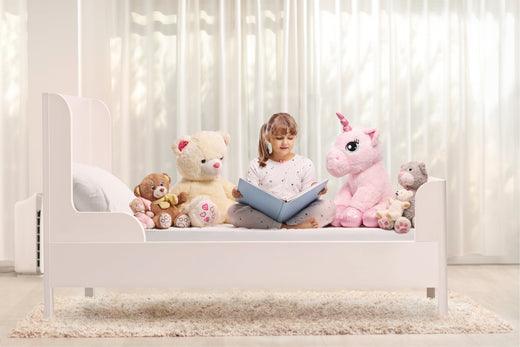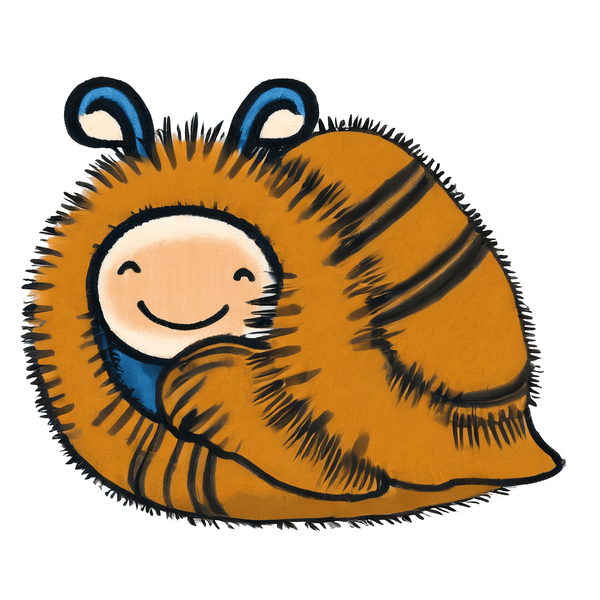
Fun and Educational Activities with Stuffed Animals
Share
Stuffed animals aren't just cuddly companions – they can also be fantastic tools for learning and play! Here are some creative ways to engage your kids with their wildlife-themed stuffed animals while fostering their development in various areas:
Math Made Fun
- Counting with Stuffed Animals: Transform ordinary playtime into an engaging math adventure! Have your child collect their plushies into a pile or bag, count their collection, organize them by size from smallest to largest, sort them into groups by color patterns, and create different sets based on animal characteristics. This hands-on approach makes basic mathematical concepts both fun and memorable.
-
Crazy Creature Census: Take counting to an exciting new level by having your child explore the fascinating world of animal features. They can compare the number of legs on different animals, count spots or stripes, and organize their stuffed friends into scientific categories (mammals, birds, reptiles). Encourage them to create simple charts to record their findings, reinforcing both counting skills and early data collection concepts. You can create a quick game by timing how fast your child can collect and sort their stuffed animals.
Unleashing Creativity
- Storytelling Sessions: Encourage your child to become a master storyteller by creating rich, detailed adventures starring their plushies. This activity naturally develops vocabulary, narrative skills, and creative thinking as they craft elaborate plots, develop distinct personalities for each character, and describe vivid settings for their tales to unfold. Suggest drawing inspiration from movies to create new adventures for their stuffed animals.
-
Stuffed Animal Show and Tell: Help your child develop presentation skills and self-confidence through organized show-and-tell sessions. Have them introduce their favorite plushie, share its detailed backstory, explain why they chose it, and describe its special characteristics. This exercise builds public speaking abilities while encouraging emotional expression. A fun idea is to have a fashion show where each stuffed animal is dressed in different clothes or clothing.
Imaginative Play and Role-Playing
- Animal Role-Playing: Develop immersive scenarios for imaginative play! Set up detailed situations where your child can act out various roles with their plushies, such as running a busy veterinary clinic, hosting an elaborate tea party, or conducting a wildlife safari. These activities foster essential social skills, including empathy, cooperation, and problem-solving, through creative play. You can also host a pretend sleepover or sleep party for stuffed animals, or take them to a coffee shop or park for imaginative play.
-
Stuffed Animal Clinic: Transform a space into an engaging veterinary clinic where your child can practice caring for their plushie patients. Include pretend medical tools, appointment schedules, and health charts. This activity sparks interest in animal care and teaches responsibility and nurturing behaviors. Use old plushies to practice repairs, such as replacing stuffing or sewing on new materials, and discuss what happens when you recycle or upcycle a stuffed toy.
Exploring Science and Nature
- Habitat Creation: Turn playtime into an interactive science exploration! Guide your child in designing and building detailed habitats for their stuffed animals, incorporating all the essential elements of real ecosystems. Have them consider and include specific food sources, water features, appropriate shelter types, and environmental factors that would affect their animals in the wild. Consider the environment and the materials used in making habitats for stuffed animals.
-
Wildlife Conservation Lessons: Use plushies as engaging teaching tools to explore critical environmental topics. Host interactive discussions about wildlife conservation, endangered species, and the delicate balance of ecosystems. Have children learn about their stuffed animals’ real-world counterparts, their natural habitats, and the challenges they face in the wild. Emphasize the importance of recycling and getting rid of old plushies responsibly to protect the environment.
Interactive Group Fun
- Teddy Bear Picnic: Organize an elaborate outdoor gathering where kids bring their favorite plushies for a social learning experience. Include themed activities like nature scavenger hunts, animal-inspired games, collaborative storytelling sessions, and educational discussions about different species and their habitats. Bring a bag of stuffed animals to the park or house for fun games, and pop surprises or treats for the animals from a bag.
- Plushie Parade: Create an energetic learning activity by combining movement with mathematical concepts! Have children arrange themselves and their stuffed animals in various patterns, counting as they march in formation. Add music, simple choreography, and specific parade routes to make the counting experience more engaging and memorable. Organize a quick game where children throw or toss their stuffed animals into a pile, or see who can get their dressed-up animal to the finish line first.
- Fashion Show: Host a fashion show activity where kids dress their plushies in different clothes and clothing, and award prizes for the best-dressed or most creative fashion. This fun idea encourages creativity and lets kids show off their fashion sense.
- Throwing Games: Play throwing games with plushies, such as tossing them into a bag or basket. These fun things can make everyone laugh and add excitement to playtime.
- Art and Craft Projects: Use old plushies for art or craft projects, such as removing stuffing to make new items, or using the materials for creative recycling. This is a great idea for teaching about upcycling and the different materials inside a stuffed toy.
- Stuffed Animal Sleepover: Organize a sleepover for stuffed animals, where kids wait for morning to see what fun things happen overnight. This sleep-themed activity sparks imagination and anticipation.
- Collect and Sort Together: A daughter or son (or grandchild!) can collect and sort their stuffed animals, and this can be a fun thing to do together, encouraging organization and bonding.
- Getting Rid of Old Plushies: Learn how to get rid of old stuffed animals by donating, recycling, or upcycling them, and discuss the impact on the environment. This teaches responsibility and sustainability.
- Stuffed Animal Adventures: Take stuffed animals on adventures to a coffee shop, park, or around the house, and use these outings as inspiration for imaginative play and storytelling.
-
Bag Fun: Use bags to store, organize, or gift plushies, and popping open a bag can add excitement to playtime and games.
These activities not only provide entertainment but also foster learning and development in various areas, making them perfect for engaging children with wildlife-themed stuffed animals. So, gather those cuddly creatures and embark on a journey of fun and learning!
Benefits of Playing with Stuffed Toys
Playing with stuffed toys offers so much more than just fun—it’s a wonderful way for kids to learn and grow. When a child grabs their favorite stuffed animal, they’re not just cuddling a toy; they’re opening the door to imaginative play that builds creativity and problem-solving skills. Through role-playing adventures, like sending a teddy bear on a daring journey or creating a whole cast of animal characters, kids develop empathy and learn to understand different perspectives. Stuffed toys also help kids practice fine motor skills as they dress, arrange, and care for their plush friends. These toys can even introduce kids to the wonders of the animal kingdom, teaching them about habitats, animal behaviors, and the importance of conservation—all while having so much fun. Whether it’s a teddy bear tea party or a wild animal safari, stuffed toys make every playtime an engaging, educational adventure.
